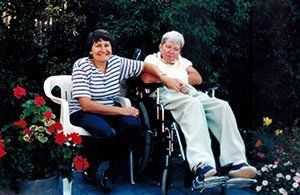Towards Effective Communication
Towards effective communication with those cognitively impaired by Alzheimer’s disease or other dementias.
1. Gain Attention
No information will be retained if the individual is not attentive or concentrating on the person giving instructions. Gain eye contact, call out the individual’s name, touch her and do not begin to talk until you are sure you have her attention. If hearing is a problem, never call out instructions when the back is turned, when a distance away or calling from another room. The sound will be a jumble of noise, which has no clarity.
2. Break down task into stages
Those with memory problems have difficulty retaining a multistage command such as “After you have finished shaving put on your blue shirt and gray trousers, and don’t forget to comb your hair.” With all this information the person with a dementia does not know where to begin. Recall will be confused and the individual will become frustrated, afraid of failing and may refuse to attempt the task. You must decide on the sequence needed to complete the task.
3. Give instructions one step at a time
Give only the information that is relevant at that time. Let all the clues in the conversation be geared to the fulfillment of that one step. Only when it has been completed should you move on to the next instruction.
4. Avoid ambiguity
Language is lost in dementia. It is not just the forgotten word, but the language becomes more concrete and is interpreted more literally. Ambiguity therefore leads to misinterpretation. Humour, which depends so much on a play on words, the double entendre, is not understood. The individual may be able to use long-term memory to tell a joke, but may not get it when told one. Euphemisms must be avoided. We must explain precisely what we mean. To “Make a bed” literally means to get out the hammer and nails; “do you need a washroom” does not literally mean, “do you have to pee?” The question “how many children do you have” may be met with the answer “I don’t have any children.” Whereas the correct answer may be produced by asking “how many sons/daughters do you have?”. In the mind of the concrete thinker, children are youngsters and have not grown up. Our words must be more literal, have less flowery descriptions and be to the point.
5. Limit distractions
Those with a dementia have difficulty interpreting the stimuli that bombard them. We may hear the siren from a fire truck in the distance, recognize what it is, assess that it is not coming to our house and then tune it out. For the person who is cognitively impaired that sound is of unknown origin and will distract her from the task at hand. It will occupy her thoughts and your words will be lost. The radio or TV playing in the background may not distract you, but it will certainly absorb the person who is having difficulty understanding and focusing on her environment.
6. Speak slowly and clearly
We must slow down our speech to the speed of the impaired person’s thinking. We must speak clearly to aid the hearing impaired and to ensure our words are not misinterpreted. When the mother tongue is not the one you are communicating in ensure your language is straightforward. Words from a second language are often lost and individuals may return to their mother tongue.
7. Use visual clues, gestures, demonstrations, pictures
Many who have dementia suffer from perceptual problems. That is, they have difficulty correctly interpreting the stimuli they receive from their environment. This may show itself through failing to understand verbal instructions, read warning signs, or recognize familiar objects and their use. If a blue shirt is placed on a blue bedspread, an impaired individual may not be able to differentiate the colours or textures and fail to locate the shirt. If the blue shirt is in a crowded closet, the individual may only see a jumbled mass of colour and not identify the shirt for its whole shape is not visible. He may face the closet, not recognize a shirt and say that there isn’t one there. Or in frustration will just keep putting back on the one taken off the previous evening. Sometimes understanding where the body is in space maybe impaired, dressing and undressing may become difficult. The individual may choose not to undress at all. Some will have difficulty initiating an action or plan a series of actions. Dressing and feeding will become more difficult. To compensate for these losses we must provide the individual with clues. Pictures and gestures may provide recognition when your words do not. Some may be able to mimic the action of another person while being unable to initiate the action. If you gesture with a toothbrush, he may be able to mimic the action. If you guide the spoon to his mouth, he may be able to carry on when the instruction “drink your soup” brought no response. What may be lost is the recognition of an objects use. Therefore the toothbrush may be used like a comb, the razor like a toothbrush. If this is the case we must ensure the safety of the individual and give clues, such as handing the person the correct object for the task.
8. Repeat
There are so many reasons why a person with a disease such as Alzheimer’s may have difficulty following instructions and performing tasks. Therefore it is important to repeat the information over and over again. We may become angry and wish to shout “but I’ve told you a thousand times…..” but it is important to understand that they are hearing it as if for the first time.
9. Limit Options
“What do you want for lunch?” May be met with “I don’t want lunch” since the individual cannot conjure an answer out of nowhere.
So you counter with “Would you like a ham and cheese sandwich or an egg salad sandwich?” and the reply is “I don’t know.” Most people with a dementia cannot make a decision and so often will reply “no.” If given a menu in a restaurant she will order what the person before her ordered – even if she has never liked it. So you say “But you never order liver.” Now the person with dementia is embarrassed, anxious, uncomfortable and has really lost her appetite.
Finally you say “How about an egg sandwich for your lunch, okay?” The sandwich gets eaten.
It is only by trial and error that we find out at what level the decision-making ability is. But by giving choice we can offer a sense of control and confidence. Sometimes that choice is purely agreeing with the decision we have made. We would not want to say “do you want your pills now?” because we don’t want her to say no. But we can offer the pills with apple juice or water. By providing limited options we give information that can be acted on. If we just ask, “What do you want?” we will be no further ahead.
10. Avoid confrontation
“I told you to meet me outside the post office.” “No you didn’t.” “Yes I did.” This is a conversation that is going nowhere. There will be no resolution to the argument. There will be two angry people. Projecting fault onto others is a defense mechanism all of us use. An object which has been misplaced, must have been stolen. We can protect ourselves when we can blame someone else. It is important that we do not enter the argument. Change the subject till the anxiety has lessened. It is possible to think more clearly when less anxious. Avoid having the last word.
11. Use residual skills
An individual with a dementia such as Alzheimer’s disease is loosing the ability to perform past learned skills. We must recognize the skills that remain and provide opportunity to perform them. This way he will remain stimulated, involved and retain self respect. Activities of a repetitive nature are best because sequencing is often difficult.
12. Reduce chance of failure
Learn the limits of her performance and attempt to secure an environment where he can function within those limits. Maybe she used to like to watch TV but now gets agitated when the commercials come on. Pre-recording programs with the commercials removed can lead to hours of enjoyment. We can use the memory loss to advantage by re-playing the same program at intervals. Indeed the familiarity often relaxes the individual whose memory loss makes her feel as if everything is new.
13. Avoid sensory overload
A person with a cognitive impairment will often have difficulty interpreting the sights and sounds of the world around her. Too much sensory input will cause confusion, anxiety and fear. It is as if a fuse blows and there can be what is known as a catastrophic reaction. That is behaviour which, to us, is out of proportion to the events occurring. There may be displays of aggression, running away, shouting etc. It is often possible to recognize the signs of this building, but often we fail to see the warning signs. Often we do not realize the distracting stimuli present when we demand action. We may feel we do not have time to wait for him to calm down before proceeding. But time invested in preventing a catastrophic reaction will be well spent in the long term.
14. Provide a calm familiar environment.
Maintain routines in daily schedules. Don’t make major changes like rearranging the furniture. If the individual has to be moved to a new setting, then take some familiar objects to be there when she arrives. When complex task are performed such as dressing and eating, ensure that distractions are minimal. If she must follow verbal instructions, ensure your voice is the one that will be noticed. Turn off the TV; close the door to others etc.
Caregivers, especially relatives, who have known an individual before the cognitive deficits changed him/her, have difficulty altering the way they relate. It is hard to break well-established habits. But the impaired person is in fact no longer the person from yesterday. The person before you now has new needs; severe limitations and can no longer live up to past expectations. It is the caregiver who must let the past go and learn to communicate on a new level. This cannot be achieved alone. All caregivers need emotional support. They must build around them a support system, a network of friends and professionals as they fulfill this difficult role.







